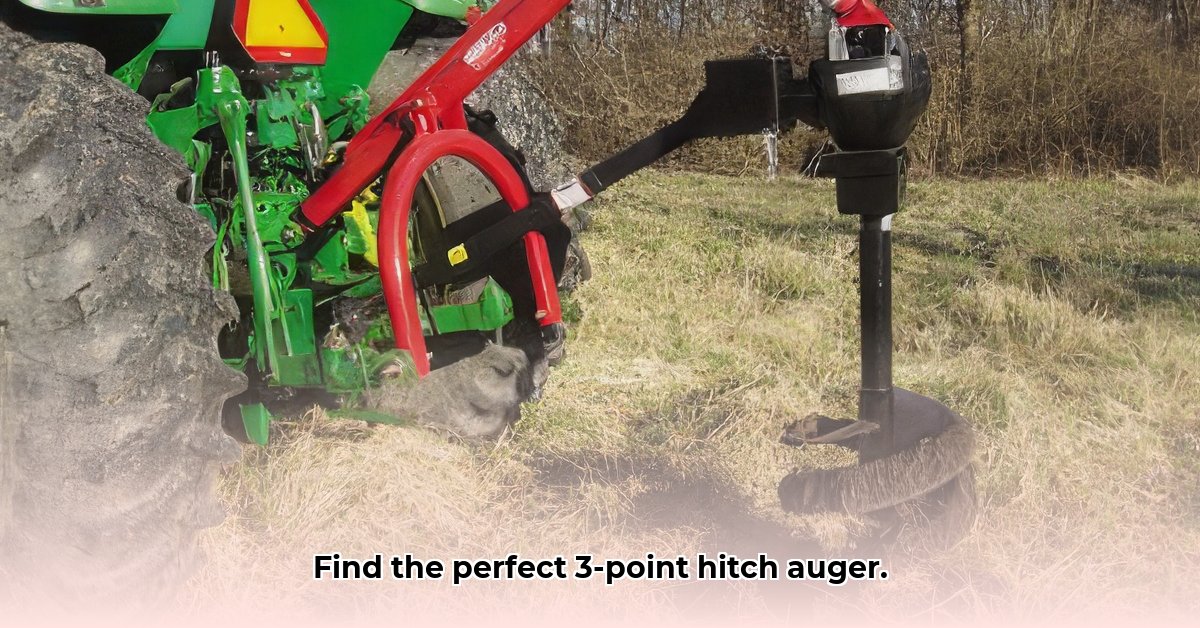
Tired of backbreaking labor digging post holes? A 3-point hitch auger, powered by your tractor's PTO (Power Take-Off), can dramatically increase efficiency and reduce strain. This comprehensive guide helps you choose the right auger, understand its operation, and prioritize safety. We'll cover everything from matching auger size to your tractor's horsepower to performing routine maintenance. Whether you're a seasoned farmer or a weekend DIY enthusiast, this guide ensures you make an informed purchase and use your auger safely and effectively. For Kubota tractor owners, check out this helpful resource: Kubota Auger info.
Matching Auger Size to Your Tractor: Power and Performance
The power of your tractor dictates the size of auger you can effectively use. Your tractor's PTO horsepower is the critical factor. Consult your tractor's manual to find this value, typically listed in horsepower (hp) or kilowatts (kW). Trying to use an auger beyond your tractor's capacity can lead to damage to both the tractor and auger.
The table below provides a general guideline. Always refer to both the auger and tractor manuals for precise compatibility information. Manufacturer recommendations supersede general guidelines.
| Tractor PTO Horsepower | Suggested Auger Size (inches) | Typical Applications | Soil Type Considerations |
|---|---|---|---|
| Under 25 hp | 6-8 inches | Light-duty tasks; small fence posts, planting saplings | Suitable for soft, easily worked soils. |
| 25-40 hp | 8-12 inches | General-purpose; fencing, smaller trees, planting | Manageable in moderately compacted or rocky soils. |
| 40-60 hp | 12-18 inches | Larger holes, denser soils, heavier work; larger posts | Effective in denser, more challenging soil conditions. |
| Over 60 hp | 18 inches and larger | Heavy-duty applications, large-scale projects | Ideal for very hard or rocky soil, large-scale projects |
Choosing the Right Auger Bit: Material and Diameter
The auger bit is the cutting edge of your operation. Two primary materials are steel and carbide. Steel bits are cost-effective for softer soils, but wear faster in rocky or hard-packed earth. Carbide bits are significantly more durable and ideal for tough soil conditions, but command a higher upfront cost.
Selecting the correct bit diameter is vital. The bit’s diameter should slightly exceed the diameter of the post or hole you are creating. A too-small bit will result in unstable installations.
- Steel Bits: Cost-effective, suitable for soft to moderately hard soils.
- Carbide Bits: More expensive but highly durable, ideal for rocky and hard soils.
Understanding Gearbox Ratios: Speed and Torque
The gearbox controls the auger's speed and torque (rotational force). Higher gear ratios provide more torque for challenging soil conditions but at a slower speed. Lower gear ratios offer faster digging speeds but may struggle in hard or rocky soils. Choosing the appropriate ratio is critical for efficiency and avoiding equipment damage. Always consult the manufacturer's recommendations to match the gear ratio to the job at hand.
Safety First: Operating Procedures and Precautions
Operating a 3-point hitch auger demands strict adherence to safety protocols. Failure to do so can result in serious injury.
- Shear Bolts: These safety devices are designed to break under excessive stress. Always carry replacement shear bolts.
- Read the Manual: Thoroughly review the owner's manual before each use.
- Safe Distance: Maintain a safe distance from the rotating auger bit at all times.
- Protective Gear: Always wear eye protection, gloves, and hearing protection.
- Environmental Awareness: Clear the area of obstacles before operation.
Auger Maintenance: Extending Lifespan and Performance
Regular maintenance is vital for prolonging the life and optimizing the performance of your auger.
- Lubrication: Lubricate all moving parts according to the manufacturer’s instructions.
- Bit Sharpening/Replacement: Sharpen or replace dull or damaged bits promptly. Dull bits reduce efficiency and can damage the auger.
- Regular Inspections: Inspect all components for wear and damage. Address any issues promptly.
Comparative Analysis: Selecting the Right Auger Model
Direct comparison of different auger models from various manufacturers can be difficult due to variations in spec reporting. Instead, focus on the following factors:
- Manufacturer Reputation: Choose a well-established manufacturer with a strong reputation for quality and reliability.
- Warranty: A longer warranty signifies confidence in product durability and reflects upon the manufacturer's trust in its equipment.
- Customer Support: Look for a manufacturer with readily available and responsive customer support options.
Remember, thorough research will help you make the best decision based on your unique needs and budget.
Conclusion: Your Path to Efficient and Safe Auger Operation
Selecting the right 3-point hitch auger depends on the specific needs of your operation. By carefully considering tractor horsepower, soil characteristics, bit selection, and safety precautions, you can ensure the efficient and safe use of this powerful tool. Remember to consult manufacturer manuals for detailed instructions and always prioritize safety.